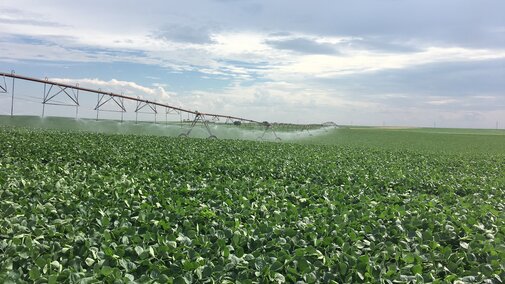Continuous corn is the most common irrigated crop sequence in southwest Nebraska. Although rotating to other crops, such as soybeans, can mitigate some production issues of continuous corn and often boost the next year’s corn yield, larger adoption of soybeans has not readily occurred in this area. According to USDA Farm Service Agency planted acreage data, on average southwest Nebraska farmers plant irrigated soybeans every fifth year.
The culture of farming in southwest Nebraska revolves around corn, which often prevents growers from raising soybeans under more ideal conditions. For example, priority is often given to planting corn first, soybeans fields are often strip-tilled, planted in 30-inch rows, and seeding rates of >160,000 seeds/ac are very common. In addition, late season chemigation with nitrogen (N) is a widespread practice without the full understanding of when and where it’s warranted (Stepanovic et al., 2018a).
The objective of this study was to investigate the impact of planting date, row spacing, seeding rates, and N management on yield and yield components of irrigated soybean in southwest Nebraska.
Description of the Two Research Sites
The study was conducted at three site-years in Perkins County, Nebraska including Kemling-2018, Stumpf-2018 and Stumpf-2019. The predominant soil type at the Kemling-2018 was Rosebud loam, while the predominant soil type at Stumpf-2018 and Stumpf-2019 was Kuma silt loam. The experimental area at Kemling-2018 was disked to incorporate compost and was planted to AG28X7 variety of soybean (MG 2.8). The experimental area at Stumpf-2018 was planted no-till to AG24X7 soybean variety (MG 2.4), while disk was used to incorporate compost and prepare the site for planting GH2499X soybean variety (MG 2.4) at Stumpf-2019. Aside from the study treatments, soybeans were grown following UNL agronomic and irrigation recommendations.
Weather Conditions in 2018 and 2019
Weather conditions in both 2018 and 2019 were characterized by cool wet springs, with significant crusting issues and hail injury (20%) in late August observed at Stumpf-2018. Direct seeding (no-till) of soybeans at the Stumpf-2018 caused issues with sidewall compaction, soil crusting, and early season growth and development. The disked soil at the Kemling-2018 amd Stumpf-2019 dried out quicker, creating better seeding conditions, less sidewall compaction, and consequently fewer issues with crusting, germination, and early season plant growth (Jasa, 2010). The seasonal temperatures were below the 30-year average in both years, while seasonal precipitation was 7 and 1 inch higher than 30-year average in 2018 and 2019, respectively (Figure 1). Total of 13 inches of irrigation water was supplemented throughout the growing season in both 2018 and 2019.
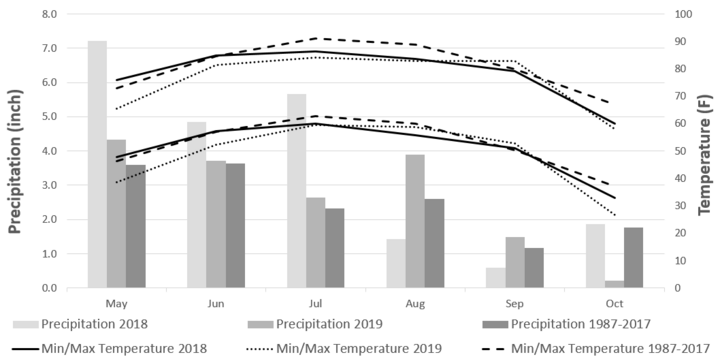
Data We Collected
The study evaluated four soybean management practices, each at two different levels, for a total of 16 treatments:
- Planting dates (early May vs early June)
- Row spacing (15 inch vs 30 inch rows; 7.5 inch rows treatment added at Stumpf-2019)
- Seeding rates (90,000 vs 140,000 live seeds/ac)
- N management – two fertility regimes (low and high):
- Stumpf-2018 – control vs chemigation 50 lbs of N/ac @ R5 (beginning seed)
- Kemling-2018/Stumpf-2019 – control vs pre-plant compost @ 5 tons/ac
Each treatment was replicated four times and each replication was divided into blocks by fertility regime. Seeding practices (planting date, row spacing, and seeding rates) were randomized within each fertility block. The study treatments were planted into strips 40 ft by 180 ft. The middle 30 ft of each strip was harvested for yield using a John Deere 9650 STS combine.
In addition, at-harvest plant population (plants/ac) was counted in each strip and ten-plant subsamples were taken to evaluate yield components, including nodes/plant, branches/plant, pods/plant, seeds/pod, and seed weight.
Soybean Yield and Yield Quality
Generally, soybeans had the best yield at the early planting date (early May) and in narrower row spacing (e.g. 15 inches), while soybean yield was not significantly increased with higher seeding rates (Figure 3).
At the Kemling-2018, early planted soybeans benefited from pre-plant application of compost at 5 ton/ac (107 bu/ac), especially at low populations (Figure 2 and 3). At the Stumpf-2018, chemigating 50 lbs of N/ac at R5 (beginning seed) did not result in a yield increase (Figure 2 and 3). Small yield increase of 2 bu/ac was observed at Stumpf-2019 following a compost application at both early and late planting dates (Figure 2 and 3).
Grain protein at Kemling-2018, Stumpf-2018 and Stumf-2019 was 32, 33, and 37, respectively (Table 1) suggesting strong interaction between the environment and genetics (variety) planted at specific site. Slight increase in grain protein (1.4%) was observed with late planting at Stumpf-2018 (Table 1). Grain oil averaged 20% over three site-years (Table 1).
Early planted soybeans had slightly higher post-harvest N in the soil (23 lbs N/ac) and plant residue (12 lbs N/ac) than later planted soybeans. For more information on soybean response to different fertility programs see Stepanovic et al. 2020b.
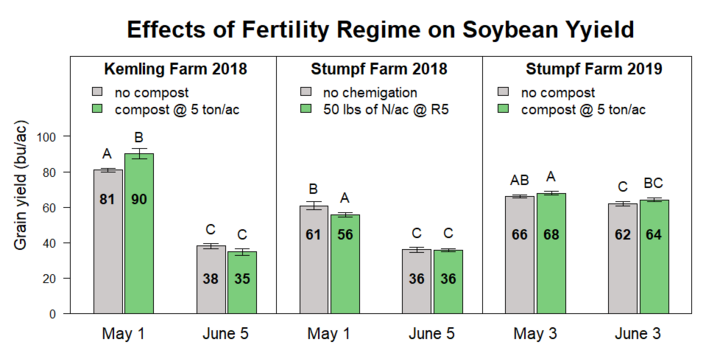

| Site-Year (variety) | Planting date | Fertility regimes | Yield (bu/ac) | Grain protein (%) | Grain oil (%) | Soil N (lbs N/ac) | N in residue (lbs N/ac) |
|---|---|---|---|---|---|---|---|
| Kemling-2018 (AG28X7) | 1-May | no-compost | 81 b | 32 a | 21 a | 84 a | 49 a |
| 1-May | compost @ 5 ton/ac | 90 a | 31 a | 21 a | 76 a | 44 ab | |
| 5-Jun | no-compost | 38 c | 31 a | 20 a | 63 a | 42 ab | |
| 5-Jun | compost @ 5 ton/ac | 35 c | 31 a | 20 a | 51 b | 30 b | |
| Stumpf-2018 (AG24X7) | 1-May | no chemigation | 61 a | 33 ab | 19 a | 77 b | 45 a |
| 1-May | 50 lbs N/ac @ R5 | 56 b | 32 b | 19 a | 95 a | 55 a | |
| 5-Jun | no chemigation | 36 c | 34 a | 19 a | 57 c | 34 a | |
| 5-Jun | 50 lbs N/ac @ R5 | 36 c | 34 a | 19 a | 62 c | 43 a | |
| Stumpf-2019 (GH2499X) | 3-May | no-compost | 66 ab | 34 a | 21 a | 49 a | 47 a |
| 3-May | compost @ 5 ton/ac | 68 a | 36 a | 21 a | 51 a | 46 a | |
| 3-Jun | no-compost | 62 c | 36 a | 21 a | 29 b | 33 a | |
| 3-Jun | compost @ 5 ton/ac | 64 bc | 37 a | 21 a | 29 b | 32 a |
What are Soybean Yield Components and Why do They Matter?
Grain yield is comprised of several components that, when analyzed separately, can allow us to better understand their individual contribution to overall grain yield. Despite differences in grain yield, the relationship between grain yield and yield components was similar at the three site-years. Table 2 summarizes correlation coefficients across three site-years. The sign of correlation coefficient (r) indicates the nature of the relationship (either positive or negative) while the magnitude of coefficient (ranging from 0 to 1) represents the strength of the linear relationship.
Generally, correlation between grain yield and plants/ac and seeds/pod was not significant, except at Stumpf-2018 where issues with crusting caused up to 60% reduction in stand (Table 2). These results suggest that: (1) changes in plant population observed in the study had no impact on grain yield, and (2) differences observed in grain yield were not affected by the number of seeds/pod.
Depending on the interaction between site-year and genetic (variety used in the study), significant positive correlation was observed between grain yield and nodes/plant, branches/plant and pods/plant suggesting that the best seeding and N management practices are those that facilitate node, branch, and pod development.
Table 2| Kemling-2018 | Grain yield (bu/ac) | Planting date | Plants/acre | Nodes/plant | Branches/plant | Pods/plant | Seeds/pod |
|---|---|---|---|---|---|---|---|
| Planting date | -0.95* | ||||||
| Plants/acre | 0.03 | 0.03 | |||||
| Nodes/plant | 0.71* | -0.73* | -0.26* | ||||
| Branches/plant | 0.39* | -0.36* | -0.42* | 0.47* | |||
| Pods/plant | 0.44* | -0.46* | -0.53* | 0.65* | 0.67* | ||
| Seeds/pod | -0.18 | 0.17 | 0.02 | -0.09 | -0.05 | -0.31 | |
| Seed weight | 0.01 | 0 | -0.13 | -0.04 | 0.18 | 0.28* | 0.11 |
| Stumpf-2018 | Grain yield (bu/ac) | Planting date | Plants/acre | Nodes/plant | Branches/plant | Pods/plant | Seeds/pod |
| Planting date | -0.87* | ||||||
| Plants/acre | -0.39* | 0.59* | |||||
| Nodes/plant | 0.41* | -0.45* | -0.38* | ||||
| Branches/plant | 0.96* | -0.74* | -0.51* | 0.39* | |||
| Pods/plant | 0.72* | -0.75* | -0.51* | 0.29* | 0.74* | ||
| Seeds/pod | -0.25 | 0.24 | 0 | 0.14 | -0.08 | -0.26 | |
| Seed weight | 0.32* | -0.27* | -0.12* | 0.05 | 0.2 | 0.06 | 0.04 |
| Stumpf-2019 | Grain yield (bu/ac) | Planting date | Plants/acre | Nodes/plant | Branches/plant | Pods/plant | Seeds/pod |
| Planting date | -0.39* | ||||||
| Plants/acre | 0.06 | 0.08 | |||||
| Nodes/plant | -0.04 | -0.35* | -0.15 | ||||
| Branches/plant | -0.02 | -0.30* | -0.22* | 0.52* | |||
| Pods/plant | -0.27* | -0.41* | -0.36* | 0.66* | 0.75* | ||
| Seeds/pod | -0.13 | 0.2 | -0.12 | -0.05 | 0.05 | 0.11 | |
| Seed weight | 0.35* | 0.06 | -0.1 | -0.02 | -0.12 | -0.18 | -0.02 |
* Correlation coefficient significant at 5% level. The sign of coefficient indicates the nature of relationship (either positive + or negative -) while the magnitude of coefficient (ranging from 0 to 1) represents the strength of the linear relationship.
Why Planting Date Matters
Previous UNL research on soybeans in eastern Nebraska has demonstrated that for each day that soybean planting is delayed after May 1, yield penalties of 0.25-0.63 bu/ac can occur, depending on the year. (Elmore et al., 2014; Specht et al., 2012) In our study, there was a wider range of daily yield penalties for late planted soybeans including 0.13, 0.64, and 1.40, bu/ac/day at the Stumpf-2019, Stumpf-2018, and Kemling-2018, respectively (Figure 4).
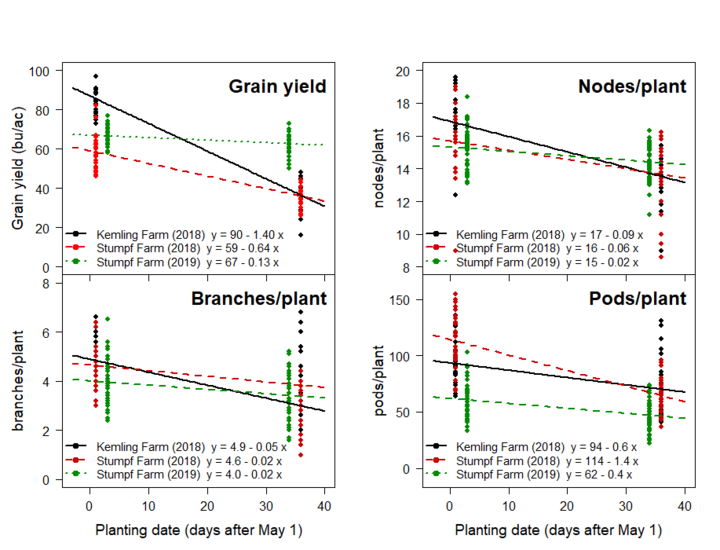
Large variability in yield response to planting dates may be attributed to the variety-specific interactions with weather, soil, and management conditions observed at each site-year. For example, soybeans planted in 2019 at Stumpf-2019 (GH2499X; 2.4 MG) yielded higher at late planting date (early June) than either of the two varieties planted in 2018 at Kemling-2018 (AG28X7; 2.8 MG) and Stumpf-2019 (AG24X7, 2.4 MG)(Figure 4). During the 2018 growing season, longer season variety (2.8 MG) planted at Kemlin-2018 (AG28X7) yielded much better at early planting dates than shorter season variety (2.4 MG) planted at Stumpf-2018 (AG24X7) (Figure 4). In addition to differences in soybean varieties, weather conditions (e.g. hail events) and management practices (e.g. tillage practices) at Kemling Farm and Stumpf Farm were much different in 2018.
Among yield components, nodes/plant, branches/plant and pods/plant were all negatively correlated with planting date (Table 2) suggesting that each soybean plant produced less nodes, branches and pods as planting date was delayed (Figure 4)
Why Row Spacing Matters
Overall, soybeans yielded higher when planted in narrower rows. At the Kemling-2018, a yield advantage of 8 bu/ac was observed with 15-inch rows at early planting, while there was no yield advantage with narrower rows at late planting date (Figure 5). At the Stumpf-2018, there was a yield advantage of 11 and 6 bu/ac with narrower rows at early and late planting, respectively (Figure 5). At the Stumpf-2019, 15 inch rows yielded 2 and 4 bu/ac more than soybeans plant in 30 and 7.5 inch rows, respectively (Figure 5). These findings are largely in agreement with our previous on-farm research studies that showed 3-13 bu/ac increases with 15-inch as compared to 30-inch rows (Stepanovic et al., 2018b). More research is needed to evaluate soybean response in 7.5 inch rows.
Seeding in narrow rows did not influence soybean node development; however, we observed enhanced branching and consequently a greater number of pods (and seeds) per plant (Figure 5). The additional pods located on the side branches contributed greatly to the yield increase in narrower rows (data not show).

Why Seeding Rate Matters Less than Other Factors
Soybean yield at all site-years did not respond to changes in plant populations. Although soybeans were seeded at 90,000 and 140,000 live seeds/ac (i.e. seeding rate after adjusting for germination), actual harvest population (plants/ac) ranged between 30,000 and 160,000 plants/ac depending on the site-year. The stand reduction in 2018 at both sites was due to early season crusting issues and hail injury.
Lack of soybean yield response to increasing populations may be explained by increased competition among the soybean plants themselves. Increasing plant population causes individual soybean plants to produce fewer branches, pods, and seeds, and consequently less yield (Figure 6).
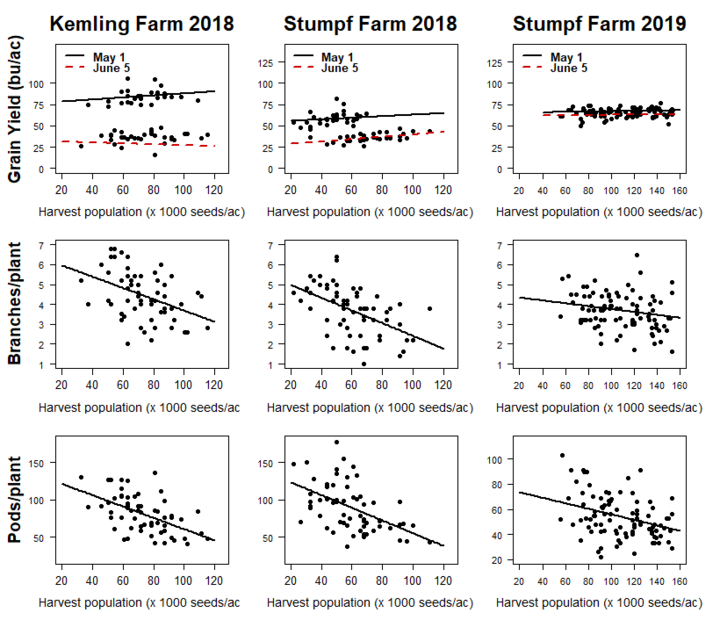
It’s All About Being More Profitable
In summary, soybean yield potential is increased when the crop is seeded earlier (0.13-1.40 bu/ac/day) and in narrower rows (up to 11 bu/ac yield advantage). This yield potential was achievable at lower seeding rates and without late season N supplementation.
It is not uncommon in western Nebraska to see soybean seeding delayed until after irrigated corn is planted, and to do it in 30-inch rows and at >160,000 seeds/ac. Assuming that yield penalties for late planting are lower for corn than for soybean, that typically there are fewer soybean acres to plant, and that market prices of soybean (~$8.00/bu) are higher than corn (~$3.00/bu), we outline potential savings from incorporating the following practices:
- Seeding soybeans before corn (10 days earlier than traditional) – $20 to $112/ac;
- Seeding soybeans in 15-inch rather than 30-inch rows with modest 3 bu/ac yield increase – $24/ac;
- Reducing seeding rates from 160,000 to 120,000 seeds/acre – $15/ac; and
- Eliminating late season chemigation with 50 lbs of N/ac – $20/ac.
Among these four production factors, early planting is the one factor that soybean growers in the region most often overlook and therefore lose the opportunity to increase their profit margins substantially. Therefore, the real question is what should we plant first in southwest Nebraska: corn or soybeans? The answer is: soybeans.
We can look to Iowa State University research for supporting data (Klein, 2009). Corn planted between April 20 and May 5 achieved 100% yield potential. Depending on year-to-year variability 99% of yield potential could still be achieved with corn planted before May 20. In the three-year study, significant yield reductions occurred only once and that was when corn planting dates were extended to late May or June. In southwest Nebraska research in 2018/2019, we observed daily yield penalties of 0.2-1.0 bu/ac/day for corn planted after May 1 (Stepanovic, 2020b; two year data).
The real question is what should we plant first to achieve optimal profitability in southwest Nebraska: corn or soybeans?
The answer is soybeans.
We strongly recommend soybean farmers in western Nebraska evaluate their seeding and fertility practices and consider implementing changes that could lead to a more profitable crop.
Acknowledgements
I would like to thank my interns Ognjen Zivkovic, Jovan Radojicic, Milica Boganovic as well as our farm technician Justin Richardson for their hard work on this project. We also thank Jim and Troy Kemling who allowed us to do this research on their farm. Lastly, we thank the Nebraska Soybean Board. Without their financial support, this project would not have been possible.
References
Stepanovic Strahinja, Arsenijevic Nemanja, Ugljic Zaim. 2018a. Is Late Season N Fertilization Warranted for Irrigated Soybean in Western Nebraska? Nebraska Extension Crop Watch
Stepanovic Strahinja, Thompson L., Glewen K. 2018b. How Row Spacng Affects Irrigated Soybean in Southwest Nebraska. Nebraska Extension Crop Watch
Stepanovic Strahinja. 2020a. Soybean Fertility Study in Western NE: What is Limiting High Yield and Protein?. Nebraska Extension Crop Watch
Stepanovic Strahinja. 2020b. Impact of Hybrid Selection, Planting Date, and Seeding Rates on Dryland Corn in Western Nebraska. Nebraska Extension Crop Watch
Jasa Paul. 2010. Recommendations for Avoiding Sidewall Compaction at Planting. Nebraska Extension Crop Watch
Elmore Roger, Specht J., Rees J., Grassini P., Glewen K. 2014. Why Planting Soybean Early Improves Yield Potential. Nebraska Extension Crop Watch
Specht Jim, Rees J., Zoubek G., Glewen K., VanDeWalle B., Schneider J., Varner D., Vyhnalek A.. 2012. Soybean Planting Date – When and Why. Nebraska Extension Cicrular EC145
Klein Bob. 2009. How Corn Planting Date Can Affect Yield. Nebraska Extension Crop Watch
